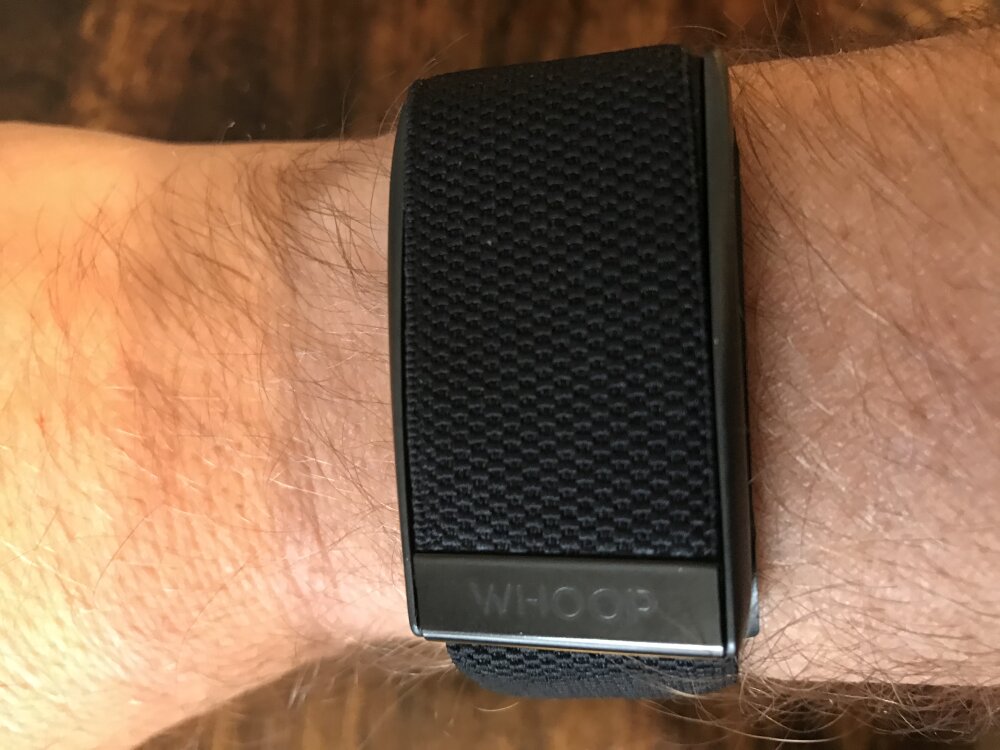The WHOOP is the silent coach always pushing you.
Forget the buzz and ignore the steps. Those are the first things I noticed when I took a fitbit off my wrist and strapped on the WHOOP about six weeks ago.
The WHOOP doesn't buzz when you reach 10,000 steps. In fact, it doesn't count steps at all. It is a silent collector of important sleep and day strain data that athletes use to train, and ultimately perform, at their highest levels. WHOOP, a life coach on your wrist, has made big inroads in professional golf.

Rory McIlroy wears a special WHOOP band that goes around his bicep, instead of his wrist.
“WHOOP helps to monitor my recovery and sleep levels daily, which ultimately determines how hard I can train. This is especially important when I’m on the road.” said McIlroy, who recently returned to No. 1 in the world. “My game has benefited as a result.”
Maybe yours can too.
How it works
WHOOP markets itself as a "human performance company" that provides a membership for 24/7 coaching to improve performance. The Boston-based company was founded in 2012. Members range from professional athletes like McIlroy and Justin Thomas to Fortune 500 CEOs, fitness enthusiasts and anyone ultra-serious about their fitness. The strap comes free with a membership costing roughly $30 a month.
What I immediately loved about the WHOOP from day 1 is its functionality. The WHOOP strap 3.0 is flexible and non-intrusive. You barely notice you're wearing it. It's not meant to be a watch (like my fitbit was). The five-day battery life is impressive, and I never have to take it off. The strap is completely waterproof, so I can wear it in the shower or while swimming. Best of all, the battery pack that charges it can be slipped on and off easily, so the strap stays on permanently while collecting data. Just don't forget to take the battery pack off before you enter the water. It is NOT waterproof.

When you first sign up for the app, the new WHOOP Journal, launched March 9, asks questions about your habits, ranging from use of alcohol and CBD oil, dietary choices and even a question or two about your sex life. You choose from a wide range of 40-plus behaviors to monitor, so you can track how these behaviors affect you day to day. From a golfer's perspective, the data could reveal trends about why some days you feel great and play well and others when you're sluggish and the score soars.
There's also a a feature to track respiratory rate, which has proven to be a critical component to detect early COVID-19 symptoms. Soon after Nick Watney's WHOOP detected his early symptoms, the Tour procured 1,000 straps to handout to all players, caddies and other essential personnel at upcoming PGA Tour, Korn Ferry Tour and PGA Tour Champions events, according to CNBC.
EXCLUSIVE! Nick Watney, the first player on the @PGATOUR to be diagnosed with #COVID19, joins @willahmed on this special edition of the WHOOP Podcast to discuss how his WHOOP data led him to getting tested for the virus.
— WHOOP (@whoop) June 27, 2020
Listen now: https://t.co/5hUZT3NJuI pic.twitter.com/KeZYI8NgW5
Strain versus sleep
Studies have shown that WHOOP can reduce injuries, increase sleep and improve performance with a continued and personalized understanding of recovery, strain and sleep. It is one of the few wearables that tracks your heart rate variability. It uses your HRV, resting heart rate and sleep patterns to determine when to push yourself in a hard workout and when to take a day off to recover. Imagine that. A fitness wearable that actually encourages you to take a day off?
If your recovery percentage score (0 to 100) is 66 or higher, the color green means go for pushing the "day strain" score higher with a good workout. If you're in the yellow (33-66), you should be more cautious because your body might be sick or worn down and still in recovery mode. Red (less than 33) means stop. These numbers and color codes are supposed to help athletes avoid injury if they attempt to push harder than their body is willing to give. Day strain metrics (0 to 21) chart how tough the day was on your body and how many calories you burned. Before a round of golf or workout, you can label the exercise with the app, or, if the activity is done consistently over time, the WHOOP can start to recognize and label it appropriately on its own (based on heart rate, strain, etc.).
Unfortunately, my WHOOP experience has been somewhat limited because I haven't been able to play golf or workout at a gym during the coronavirus pandemic. For example, I'd love to know what my 'day strain' is for walking 18 holes at my home course. Meanwhile, my sleep patterns during this uncertain time of "sheltering in place" have been erratic. That's been interesting to watch. Rarely am I reaching my optimum of 7 hours, 50 minutes.
All the data collected by the strap is downloaded when you open the WHOOP app. It's important to open the app at least every 2-3 days and leave your bluetooth activated to make sure the tracking data stays current and complete. Eventually, I'll be able to compare month over month to see if I'm trending fitter or fatter. I'm avoiding the latter, one workout, one sleep cycle and one meal at the time.
Are you wearing a WHOOP or interested in it for your own fitness goals? Let us know in the comments below.











Sounds wonderful but not feasable price wise for me as I am a single 70 year old female